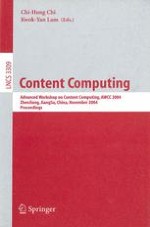2004 | Buch
Content Computing
Advanced Workshop on Content Computing, AWCC 2004, ZhenJiang, JiangSu, China, November 15-17, 2004. Proceedings
herausgegeben von: Chi-Hung Chi, Kwok-Yan Lam
Verlag: Springer Berlin Heidelberg
Buchreihe : Lecture Notes in Computer Science
Enthalten in: Professional Book Archive
